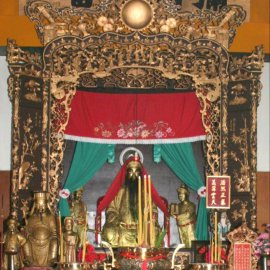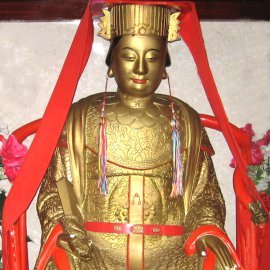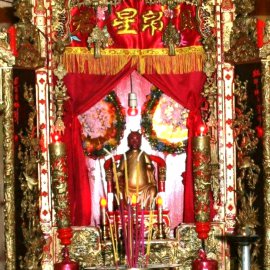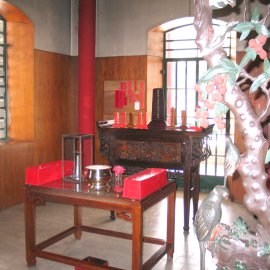

NSFK Pagoda

Nam Shun Fooy Koon
Pagoda
NSFK Pagoda
NAM SHUN
FOOY KOON
NAM SHUN
FOOY KOON
NAM SHUN FOOY KOON




GUAN DI
Kwan Tee or Guan Di was a great warrior and at the same time, a man of honour known for his righteousness and benevolence.
JIU SIN SUN WAI
Shrine for the dead. It is customary for the Cantonese community to have the souls of those who passed away to rest at the Kwan Tee Pagoda.
GODDESS TIN H
Tin Hao isthe goddess of the sea. Those travelling abroad pray this goddess to protect them or their relatives for a safe journey.
GOD OF GOOD FORTUNE
Kwan Tee or Guan Di, God of Good Fortune and Shrine for the dead are in the same Pagoda.
Besides the altar for Kwan Tee, the pagoda also houses one altar for the God of Good Fortune (Choy Sun) and a shrine for the dead (Jiu Sin Sun Wai) It is customary for the Cantonese community to have the souls of those who passed away to rest at the Kwan Tee Pagoda. This is done after burial when the eldest son or a very close relative of the deceased takes a lit joss-stick from the cemetery to the pagoda and places it in the shrine for the dead. This allows relatives and friends to pray and pay respects to their dear ones who departed from this world whenever they go to the pagoda. This practice is often called “Le Culte aux Ancêtres”.
The Tin Hao Pagoda, on the other hand houses the Tin Hao goddess, who is the goddess of the sea. Those who have relatives who travel abroad for studies or others, usually pray this goddess to protect their relatives during the journey and also to make them
have a safe and good return back home.
The Nam Shun Fooy Koon Pagodas remain the main place of worship for the Cantonese community, in addition to the other smaller pagodas located in Port Louis, mainly in China Town and are the venue for a number of religious celebrations in the course of the year, namely:
Chinese Festivals that are celebrated in Mauritius
• The Chinese new year festival; which is celebrated around January or February every year.
• The Tin Hao festival; which is the celebration of the anniversary of the Goddess and this is celebrated around March/April every year.
• The Kwan Tee festival; which is the celebration of the anniversary of Kwan Tee and this is celebrated in August every year.
• Every 1st and 15th day of the Chinese calendar, candles and joss sticks are lit and fruits are offered to the gods in both pagodas.
The Pagodas are a place of worship but they also form an important part of the rich Mauritian cultural heritage. They are therefore open to the general public and visitors are most welcome.
Nam Shun Fooy Koon pagodas are located next to the Champs de Mars race course in Port Louis. It consists of two pagodas, the Kwan Tee Pagoda and the Tin Hao Pagoda.
The Kwan Tee Pagoda was first built in 1895 on the premises of the Cantonese society - Nam Shun Fooy Koon and the old dilapidated structure was completely overhauled in the late 1970's and the new building as we see it today was inaugurated in November 1980. During the reconstruction the walls of the pagoda was left untouched. The original statues and interior decorations, made of special wood and beautifully crafted, which were all imported from China, were restored and re-installed in the building. The wooden portion of the building was replaced by concrete and the roof supported by concrete pillars instead of wooden beams. Kwan Tee was a great warrior and at the same time, a man of honour known for his righteousness and benevolence. At his death, he became a hero and was deeply revered by the Chinese people.


GUAN DI
Kwan Tee or Guan Di was a great warrior and at the same time, a man of honour known for his righteousness and benevolence.
GODDESS TIN H
Tin Hao isthe goddess of the sea. Those travelling abroad pray this goddess to protect them or their relatives for a safe journey.

GOD OF GOOD FORTUNE
Kwan Tee or Guan Di, God of Good Fortune and Shrine for the dead are in the same Pagoda.

JIU SIN SUN WAI
Shrine for the dead. It is customary for the Cantonese community to have the souls of those who passed away to rest at the Kwan Tee Pagoda.
Besides the altar for Kwan Tee, the pagoda also houses one altar for the God of Good Fortune (Choy Sun) and a shrine for the dead (Jiu Sin Sun Wai) It is customary for the Cantonese community to have the souls of those who passed away to rest at the Kwan Tee Pagoda. This is done after burial when the eldest son or a very close relative of the deceased takes a lit joss-stick from the cemetery to the pagoda and places it in the shrine for the dead. This allows relatives and friends to pray and pay respects to their dear ones who departed from this world whenever they go to the pagoda. This practice is often called “Le Culte aux Ancêtres”.
The Tin Hao Pagoda, on the other hand houses the Tin Hao goddess, who is the goddess of the sea. Those who have relatives who travel abroad for studies or others, usually pray this goddess to protect their relatives during the journey and also to make them
have a safe and good return back home.
The Nam Shun Fooy Koon Pagodas remain the main place of worship for the Cantonese community, in addition to the other smaller pagodas located in Port Louis, mainly in China Town and are the venue for a number of religious celebrations in the course of the year, namely:
Chinese Festivals that are celebrated
in Mauritius
•The Chinese new year festival; which is celebrated around January or February every year.
•The Tin Hao festival; which is the celebration of the anniversary of the Goddess and this is celebrated around March/April every year.
•The Kwan Tee festival; which is the celebration of the anniversary of Kwan Tee and this is celebrated in August every year.
•Every 1st and 15th day of the Chinese calendar, candles and joss sticks are lit and fruits are offered to the gods in both pagodas.
The Pagodas are a place of worship but they also form an important part of the rich Mauritian cultural heritage. They are therefore open to the general public and visitors are most welcome.
Nam Shun Fooy Koon
Copyright Nam Shun Fooy Koon 2006 - 2022 - All Rights Reserved - Legal Mentions - Cookie Policy -Terms & Conditions
Designed: Red Apple Designs